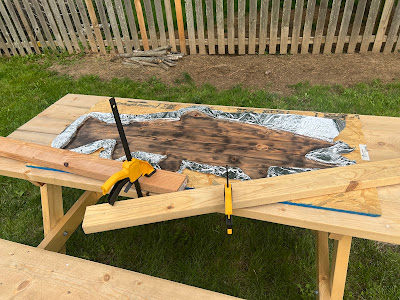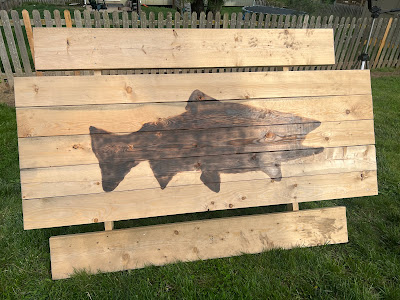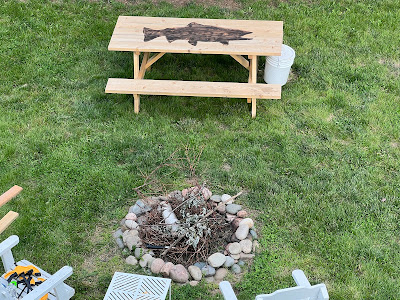After talking to a few folks that I work with, the idea of wrapping the edges of the stencil I created with aluminum foil seemed to potentially offer some aid in getting clean lines from the torching process. The hopes were that the foil would help to reflect heat and also create a tighter seal between the top of the picnic table and the stencil. To also aid in getting more contact between the stencil and top of the table, I used a 2 X 4 and some clamps. Later on I found out that these clamps would come in handy by keeping the stencil in place as well. I had overlooked the fact that I needed to make sure the stencil didn't shift in location or I might lose my clean lines.
With everything sealed and clamped, I was ready to start torching some edges. It didn't take long for me to realize that the torch wasn't going to work upside down. I ended up tilting the table on its edge and that solved the problem. With the torch being able to continuously work, I started to torch the edges of the stencil. I made sure to start torching away from the edges and carefully work my way to the boundaries. I didn't want to hit the edges with a flame that was too intense or at an angle that would usher the flame under the stencil.
As I finished one edge, I removed one set of clamps, moved the set to the other side of the stencil, and then reset them. I did the same thing with a second set of clamps. This helped ensure that the stencil would not shift its position. After I applied the same techniques to the opposite side, I was almost done. All I needed to do was torch from the edges to the middle of the stencil. This was less stressful but I still needed to be careful. There is a difference between toasting and scorching wood. I have learned that you can always burn a little more but can't remove the burn marks once they are present...unless you want to sand things down which I didn't want to do.
After everything was torched to satisfaction, it was time for the big reveal. To say that I was nervous to see the final product would be a gross understatement. The final product was there but I wasn't sure what it looked like. I wasn't sure if success, failure, or somewhere in between laid under that plywood and foil. I pulled my hat down low so that I couldn't see and then moved the board off the table. I wanted to see it all at once, for better or worse. To my amazement, it looked great! The lines were pretty clean and you could tell that it was a fish! I am thrilled with the results and now I'm thinking about other projects that I can apply this technique to.










No comments:
Post a Comment